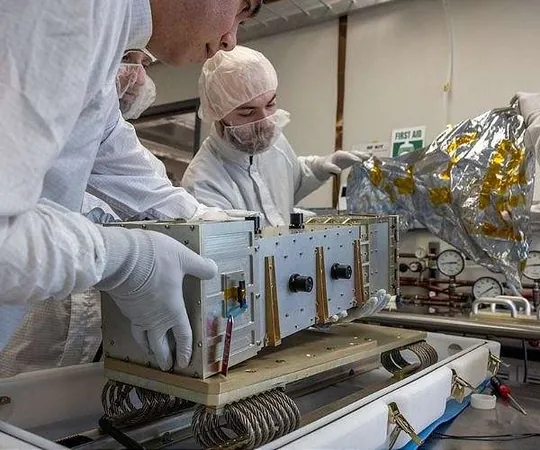
NASA's Groundbreaking Mission: Get Ready for X-Ray Vision of Earth's Magnetosphere!
2025-01-05
Author: Ming
NASA's Groundbreaking Mission: Get Ready for X-Ray Vision of Earth's Magnetosphere!
Holy Space! NASA is set to revolutionize our understanding of Earth’s protective magnetic shield with its innovative Lunar Environment Heliospheric X-ray Imager—affectionately dubbed LEXI. As part of the ambitious Artemis campaign, LEXI will embark on its maiden voyage to the Moon, capturing the very first global images of our planet's magnetosphere, which stands as a crucial barrier against harmful solar radiation.
Launching from the Kennedy Space Center in Florida no earlier than mid-January 2025, this ambitious mission comes through NASA's Commercial Lunar Payload Services (CLPS) initiative, utilizing Firefly Aerospace's cutting-edge Blue Ghost Lander. With a suite of 10 payloads aboard, LEXI aims to unlock the mysteries of how space weather, which is heavily influenced by solar activity, interacts with our home planet.
Once LEXI touches down on the lunar surface, it will switch on and begin its critical observations. As it gazes back toward Earth over a six-day period, LEXI will collect X-ray images emitted from the fringes of our planet's vast magnetosphere—an area known as the magnetopause. These observations are not just a scientific curiosity; they will provide vital insights into how this protective shield responds to intermittent cosmic forces, including solar events that trigger stunning auroras—as well as potential disruptions to technology, like satellites and power grids.
Brian Walsh, a leading space physicist and principal investigator of LEXI, emphasized the mission's significance: “We’re trying to get this big picture of Earth's space environment. A lot of physics can be esoteric or difficult to follow without years of specific training, but this will be science that you can see.”
The X-rays LEXI is set to detect stem from a fascinating interaction: when solar wind—a constant stream of charged particles emitted by the Sun—collides with Earth's magnetic field, low-energy X-rays are released. By positioning LEXI on the Moon, researchers will gain a comprehensive view of the magnetopause like never before.
In addition to monitoring how the magnetosphere swells and shrinks with varying solar winds, LEXI is also prepared to capture the elusive magnetic reconnection events. These phenomena occur when the field lines of the magnetosphere merge with those of the solar wind, releasing high-energy particles that cascade down toward Earth’s poles. This breakthrough understanding could shed light on whether such reconnections happen simultaneously at multiple locations or in a steady flow.
While auroras are a breathtaking result of these solar particles entering our atmosphere, they also pose risks, including potential damages to satellites and disruptions to electrical grids on Earth. By understanding this cosmic ballet, scientists aim to bolster protections for our essential infrastructures both on the ground and in space.
This isn't LEXI's first dance with the cosmos. Originally launched in 2012 under the name STORM, the instrument was confined to a display case for a decade after its mission. But thanks to a renewed vision from Walsh and the team at NASA's Goddard Space Flight Center, LEXI has received a makeover and is now primed to provide groundbreaking science under the CLPS initiative.
The CLPS model signals a new era of space exploration, encouraging commercial partnerships for lunar exploration and enabling the growth of industry services. As NASA prepares to ride this wave of innovation, the agency aims to foster a thriving ecosystem of lunar commerce and exploration—setting the stage for future pioneers to venture into deep space.
Stay tuned as we witness history in the making—who knows what secrets LEXI will unveil from its lunar perch that could change our understanding of Earth forever!


 Brasil (PT)
Brasil (PT)
 Canada (EN)
Canada (EN)
 Chile (ES)
Chile (ES)
 Česko (CS)
Česko (CS)
 대한민국 (KO)
대한민국 (KO)
 España (ES)
España (ES)
 France (FR)
France (FR)
 Hong Kong (EN)
Hong Kong (EN)
 Italia (IT)
Italia (IT)
 日本 (JA)
日本 (JA)
 Magyarország (HU)
Magyarország (HU)
 Norge (NO)
Norge (NO)
 Polska (PL)
Polska (PL)
 Schweiz (DE)
Schweiz (DE)
 Singapore (EN)
Singapore (EN)
 Sverige (SV)
Sverige (SV)
 Suomi (FI)
Suomi (FI)
 Türkiye (TR)
Türkiye (TR)
 الإمارات العربية المتحدة (AR)
الإمارات العربية المتحدة (AR)